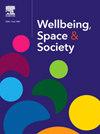Negotiating connections, confinements, and neighbourhood places: Older adults’ everyday well-being during the COVID-19 pandemic and beyond
IF 2.2
Q2 GEOGRAPHY
引用次数: 0
Abstract
The COVID-19 pandemic profoundly disrupted society and raised concerns about the well-being of older adults. Today, many people have abandoned ‘pandemic protocols’ but questions remain about the pandemic's longer term impacts on older adults. We used digitally mediated photovoice to explore older adults’ well-being in the context of their everyday lives, early in the pandemic and again two years later. Nine apartment-dwelling older adults who lived in high-density neighbourhoods in Vancouver, Canada participated in our study. We holistically considered how five dimensions of well-being were interrelated to shape experiences: material, relational, subjective, psychological, and environmental. We explored positive and negative aspects of these dimensions in relation to two key themes: (i) negotiating comfort, purpose and confinement at home, and (ii) navigating neighbourhood places amidst pandemic disruptions. Material resources to meet one's needs (e.g., communication technology, hobbies) and access to public and private greenspaces were assets. However, some participants experienced increased barriers to maintaining the five overlapping dimensions of well-being we examined; these participants viewed their homes negatively, and engaged less with their neighbourhoods over time. We emphasize how older adults’ well-being during the pandemic was a dynamic and, at times, precarious process. Understanding how interrelated dimensions shape older adult well-being might ultimately inform practices and policies that promote age-friendly cities.
协商联系、限制和邻里场所:COVID-19 大流行期间及之后老年人的日常福祉
COVID-19 大流行严重扰乱了社会,并引发了对老年人福祉的担忧。如今,许多人已经放弃了 "大流行病规程",但关于大流行病对老年人的长期影响的问题依然存在。在大流行初期和两年后,我们利用数字媒介摄影舆论来探讨老年人在日常生活中的幸福感。九位居住在加拿大温哥华高密度社区的老年人参与了我们的研究。我们从整体上考虑了福祉的五个方面是如何相互关联以形成体验的:物质、关系、主观、心理和环境。我们结合以下两个关键主题,探讨了这些方面的积极和消极因素:(i) 在舒适、有目的和封闭的家中进行协商,以及 (ii) 在大流行病的干扰下在邻里之间进行游走。满足个人需求的物质资源(如通信技术、爱好)以及使用公共和私人绿地的机会都是财富。然而,一些参与者在保持我们所研究的五个相互重叠的幸福感方面遇到了更多的障碍;这些参与者对自己的家持负面看法,而且随着时间的推移,他们与社区的接触也越来越少。我们强调老年人在大流行病期间的幸福感是一个动态的过程,有时甚至是不稳定的过程。了解相互关联的因素是如何影响老年人福祉的,最终可能会为促进老年友好型城市的实践和政策提供参考。
本文章由计算机程序翻译,如有差异,请以英文原文为准。
求助全文
约1分钟内获得全文
求助全文
来源期刊

Wellbeing Space and Society
Social Sciences-Social Sciences (miscellaneous)
CiteScore
2.70
自引率
0.00%
发文量
46
审稿时长
124 days
 求助内容:
求助内容: 应助结果提醒方式:
应助结果提醒方式:


